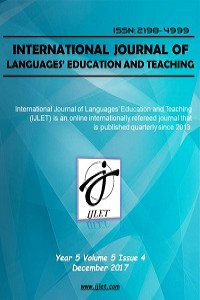Öz
Advertising is a prominent discourse type which is inevitably linked to a range of disciplines. This study examines the language of a non-product advertisement, not isolating it from its interaction with other texts that surround it. It is based on Fairclough’s Critical Discourse Analysis (CDA) framework in which there are three levels of analysing texts: description, interpretation and explanation. In addition to analysing the advertisement at hand in terms of these three levels, the study includes semi-structured interviews conducted with English language teacher candidates. The purpose is to explore the social function of advertising not only from sounds, sights and language of the text, but also assess the impact of these on teacher candidates’ views. To this end, three teacher candidates were interviewed; they were asked to explain how they related the advertisement to their own context. Findings from the inductive content analysis of interviews point to the fact that there is a close connection between the advertisement discourse and the “teacher” image in the minds of participants. The core results imply that integrating discourse analysis activities in teacher education programs can be fruitful in regard to gaining insight into how to question ideologies critically and resist manipulations. Thus, teacher candidates will be able to teach their future students how the use of language influences our understanding of social or moral issues transmitted through media.
Anahtar Kelimeler
Critical discourse analysis (CDA) advertising teacher education
Kaynakça
- Abdelaal, N. M. & Sase, A. S. (2014). Advertisement analysis: A comparative critical study. Advances in Language and Literary Studies, 5(6), 254-259.
- Ahmed, N. (2000). Cross-cultural analysis of advertising from the United States and Indian. Retrieved from www.dissertstion.com/library/1120842a.htm
- Bloor, M. & Bloor, T. (2007).The practice of critical discourse analysis. An Introduction. London: Hodder Education.
- Fairclough, N. (1992). Discourse and scial change. Cambridge: Polity Press.
- Foucault, M. (1975).Discipline and punishment: The birth of the prison. New York: Vintage Books.
- Gee, J. P. (1999). An introduction to discourse analysis: Theory and method. Routledge, New York.
- González Ruiz, S. (2014). The discourse analysis of cosmetic advertising: Max Factor’s discursive development from 1940 to the present. Retrieved from https://uvadoc.uva.es/bitstream/10324/8022/1/TFG_F_2014_40.pdf
- Halliday, M.A.K. (1994). Introduction to functional grammar. London Edward Arnold.
- Kress, G. & L. Van, T. (1990). Reading images. Geelong, Victoria: Deakin University Press.
- Lunga, V. B. (2006). Unpacking stanbic bank's pan African brand campaign using critical discourse analysis. Retrieved from www.ub.bw/cad/cssu/profiles/lunga.pdf.
- O'keeffe, A. (2011). Media and discourse analysis. Retrieved from https://dspace.mic.ul.ie/bitstream/handle/10395/1681/O%20?sequence=2
- Tahmasbi, S. & Kalkhajeh, S. G. (2013). Critical discourse analysis: Iranian banks advertisements. Asian economic and financial review, 3(1), 124.
- Vahid, H. & Esmae'li, S. (2012). The power behind images: Advertisement discourse in focus. International Journal of Linguistics, 4(4), 36.
- van Dijk, T. A. (1985). The handbook of discourse analysis. London: Academic Press.
- van Dijk, T. A. (1998). Ideology: A multidisciplinary approach. Sage.
- Williams, K. (2003). Understanding media theory: Representation, audience, ideology, effects, production, text. London: Hobber Arnold.
Öz
Anahtar Kelimeler
Critical discourse analysis (CDA) advertising teacher education
Kaynakça
- Abdelaal, N. M. & Sase, A. S. (2014). Advertisement analysis: A comparative critical study. Advances in Language and Literary Studies, 5(6), 254-259.
- Ahmed, N. (2000). Cross-cultural analysis of advertising from the United States and Indian. Retrieved from www.dissertstion.com/library/1120842a.htm
- Bloor, M. & Bloor, T. (2007).The practice of critical discourse analysis. An Introduction. London: Hodder Education.
- Fairclough, N. (1992). Discourse and scial change. Cambridge: Polity Press.
- Foucault, M. (1975).Discipline and punishment: The birth of the prison. New York: Vintage Books.
- Gee, J. P. (1999). An introduction to discourse analysis: Theory and method. Routledge, New York.
- González Ruiz, S. (2014). The discourse analysis of cosmetic advertising: Max Factor’s discursive development from 1940 to the present. Retrieved from https://uvadoc.uva.es/bitstream/10324/8022/1/TFG_F_2014_40.pdf
- Halliday, M.A.K. (1994). Introduction to functional grammar. London Edward Arnold.
- Kress, G. & L. Van, T. (1990). Reading images. Geelong, Victoria: Deakin University Press.
- Lunga, V. B. (2006). Unpacking stanbic bank's pan African brand campaign using critical discourse analysis. Retrieved from www.ub.bw/cad/cssu/profiles/lunga.pdf.
- O'keeffe, A. (2011). Media and discourse analysis. Retrieved from https://dspace.mic.ul.ie/bitstream/handle/10395/1681/O%20?sequence=2
- Tahmasbi, S. & Kalkhajeh, S. G. (2013). Critical discourse analysis: Iranian banks advertisements. Asian economic and financial review, 3(1), 124.
- Vahid, H. & Esmae'li, S. (2012). The power behind images: Advertisement discourse in focus. International Journal of Linguistics, 4(4), 36.
- van Dijk, T. A. (1985). The handbook of discourse analysis. London: Academic Press.
- van Dijk, T. A. (1998). Ideology: A multidisciplinary approach. Sage.
- Williams, K. (2003). Understanding media theory: Representation, audience, ideology, effects, production, text. London: Hobber Arnold.
Ayrıntılar
| Birincil Dil | İngilizce |
|---|---|
| Konular | İkinci Bir Dil Olarak İngilizce, Dil Çalışmaları (Diğer), Uygulamalı Dilbilim ve Eğitim Dilbilimi |
| Bölüm | Araştırma Makalesi |
| Yazarlar | |
| Yayımlanma Tarihi | 30 Aralık 2017 |
| Yayımlandığı Sayı | Yıl 2017 Cilt: 5 Sayı: 4 |


